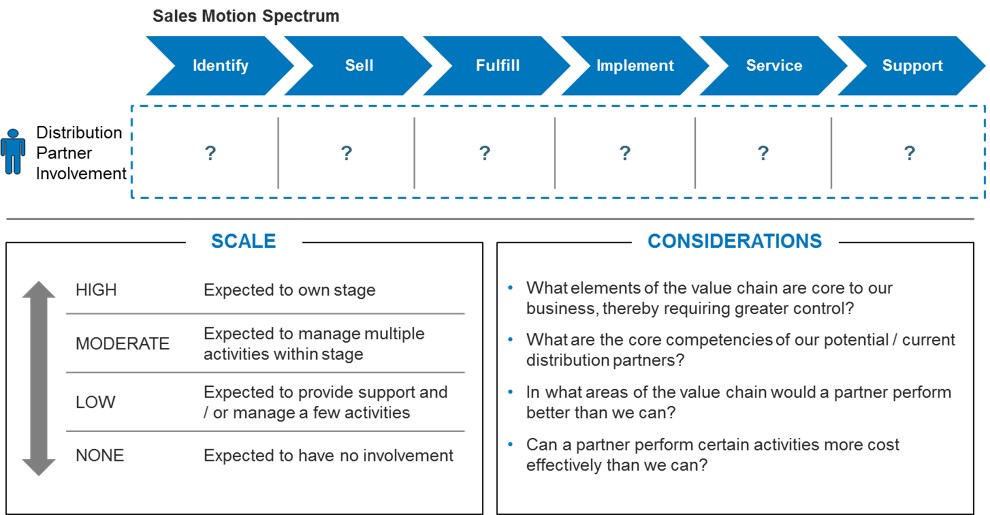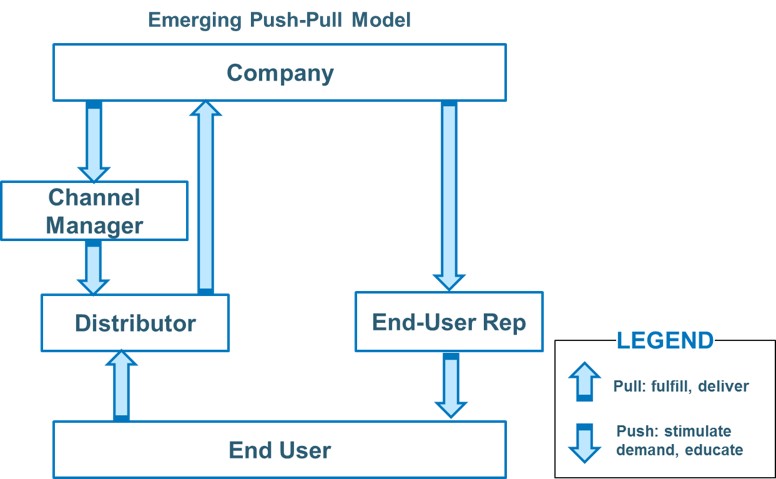Balance the Push-Pull of Your Indirect Channel Strategy

Some manufacturers have long leveraged distributors as their primary go-to-customer channel. Others are looking to update their route to market through newly formed distributor relationships. Either way, understanding how to both stimulate end-user demand while continuing to build strong channel partner relationships can be challenging. A hybrid push-pull model is essential, but manufacturers will need to delicately balance all elements.
Push-pull sales models are those in which sellers stimulate demand at the end-user (the pull) and work in concert with channel managers who support channel partners to fulfill the product (the push). According to a recent AGI manufacturer survey, 72 percent of respondents with a material channel presence today face the need to increase deployment of “push-pull” sales models to do just that. Deploying this hybrid model can be complex. Manufacturers should consider three important steps for a successful deployment: understand where your partner fits in the value chain; articulate the vision and rules of engagement; and communicate the wins to gain momentum:
Step 1: Understand Where Your Channel Partner Fits on the Value Chain
What are we paying channel partners to do, and what value do they bring? This foundational question is important in understanding how to appropriately and effectively coordinate efforts through the demand generation pull process. Channel partners will have some degree of involvement in one or multiple steps in the sales motions spectrum:

For example, if the channel partner primarily contributes to order fulfillment, the manufacturer should deploy a resource to influence the end-user and drive specification. The channel partner may have sellers–and they likely provide value through offering complementary products. But, the manufacturer needs to ask some basic questions to understand the degree of involvement partners might have in influencing the sale:
- Can the manufacturer primarily rely on them to support selling activities? Do they have core competencies to support this?
- Do partners have sellers that prioritize the manufacturer’s products?
- Are partners capable and willing to follow through with the sales process when the specifier differs from the end-user/buyer?
If the manufacturer is not a top-line, the answer may be “no.” On the other end of the spectrum, the manufacturer may be reliant on the channel partner’s value in identifying and qualifying new leads or developing and presenting solutions to create that pull-through. In this case, sales leaders likely need a different approach and support resource to work more closely with the channel partner to develop the strategy and manage key accounts and pursuit opportunities.
Step 2: Share the Vision and Articulate Rules of Engagement
Once the manufacturer understands what it expects of its channel partners, it is imperative to share the vision for the future, i.e., the strategy behind the push-pull model and the benefits expected through collaboration. Just as importantly, it is crucial to establish clear rules of engagement between the channel partner, the channel manager and the seller tasked with generating the pull-through demand. Specifically, manufacturers should ask:
- What are the activities and responsibilities to coordinate efforts and manage opportunities from identification to close?
- What tools, technology or processes do we have available to support our efforts?
- Are there accounts or segments we should focus on? Are there accounts or segments that are off limits?
The first question is especially fundamental if sales leaders are looking for channel partners to help influence specifiers who are different from the buyer. This is where the coordination between the channel and the demand-stimulator is especially crucial.
Step 3: Communicate the Wins to Gain Momentum
An obvious concern with dedicating a resource to the pull is a perception from the channel partner that they’ve lost influence over the sale. Done the right way, manufacturing leaders can convey the pull as their commitment to the distributor channel; channel partners will appreciate having a resource dedicated to increasing sales through generating demand (although it might take some time). It is critical to share successes on how the partnership has increased the bottom line at both companies. This inevitably leads to greater distributor mind-share and collaboration. It is also the true value manufacturing sales leaders should weigh when determining the cost-benefit for deploying a push-pull model.
When manufacturers take the time to understand their channel partners’ value position, articulate a vision and rules of engagement and communicate wins to gain momentum, the result is greater end-user demand and stronger channel partner relationships.

Learn More
Learn more about the Alexander Group’s Manufacturing practice or contact us to understand how AGI can help you assess or enhance your go-to-customer sales model.

